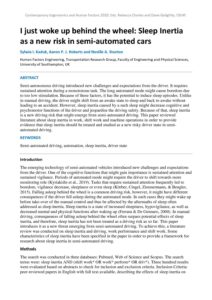| Document | Author Sylwia I. Kaduk, Aaron P. J. Roberts and Neville A. Stanton |
| Abstract Semi-autonomous driving introduced new challenges and expectations from the driver. It requires sustained attention during a monotonous task. The long automated mode might cause boredom due to too low stimulation. Because of these factors, it has the potential to induce sleep episodes. Unlike in manual driving, the driver might shift from an awake state to sleep and back to awake without leading to an accident. However, sleep inertia caused by a such sleep might decrease cognitive and psychomotor functions of the driver and jeopardise the driving safety. Because of that, sleep inertia is a new driving risk that might emerge from semi-automated driving. This paper reviewed literature about sleep inertia in work, shift work and machine operations in order to provide evidence that sleep inertia should be treated and studied as a new risky driver state in semi-automated driving. |

